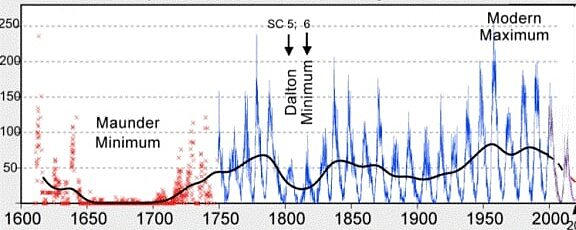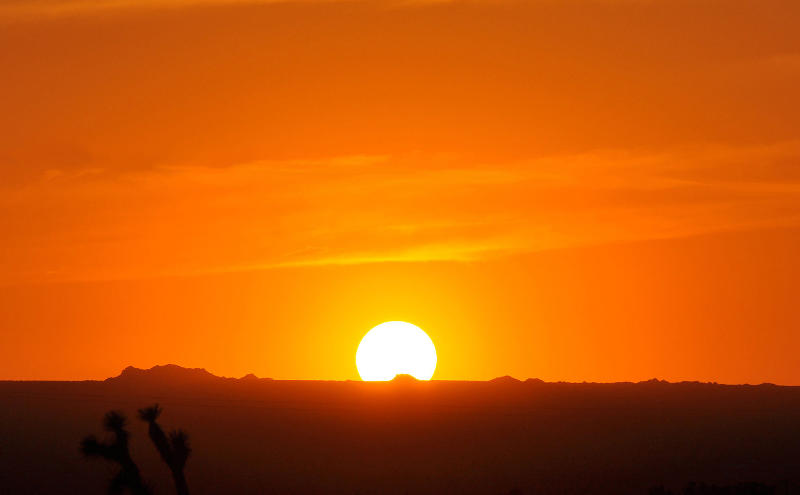Preparing For The Grand Solar Minimum
Will anyone recognize that a Grand Solar Minimum is apparently coming? And what are they (or you) going to do about it? How much of the food supply might be affected and how to prepare for it?
by Anony Mee
We engage in a preparedness lifestyle just in case misfortune befalls us. We often discuss what sorts of events those might be – loss of a job, medical emergencies, wars of various sorts, and how to prepare. Ken does a survey generally every year on what we’re all prepping for. It’s always interesting to see the results and comments on that article.
This past month I’ve written two articles for American Thinker on the Modern Grand Solar Minimum and, in the process, have managed to scare myself. (The Coming Modern Grand Solar Minimum)
My grandparents and parents lived through the Great Depression and the Dust Bowl. Mom’s family were wheat farmers. Dad’s folks were just plain dirt poor. They all suffered. Contemplating several years of low harvests, on a global scale, with perhaps more years of lingering bad weather, is still hard for me to wrap my head around.
Grand Solar Minimum – Once-In-Every-400-Years Event
No matter what else might happen in our lives, our families, our neighborhoods, or our country, our world is facing predictable dark cold years, estimated to begin in 2028 and continue at least through 2032. The low point of a Grand Solar Minimum is a once-in-every-400-years event.
I’m convinced that all the “noise” from the pandemic – the stupid shutdowns, the shortages due to pandemic-related issues, etc. – has masked the beginning of the Grand Solar Minimum. 2019 and 2020 saw failed or limited harvests over much of the globe, mostly due to weather. We’ll see if this year is any better. Hope it will be, but the lack of sunspot activity is grim, and it’s early in the minimum cycle for it to be so low.
The Year Without A Summer

1816 was the year without a summer. It was the trough of the Dalton Minimum. It was not even a Grand Solar Minimum (see the chart above).
The Dalton Minimum was also impacted by the 1815 massive eruption of Mt. Tambora in Indonesia. Violent eruptions tend to coincide with solar minimums.
In September 1816 Thomas Jefferson wrote to a friend, “We have had the most extraordinary year of drought & cold ever known in the history of America. . . . The crop of corn thro’ the Atlantic states will probably be less than ⅓ of an ordinary one, that of tobo still less, and of mean quality. The crop of wheat was midling in quantity, but excellent in quality. But every species of bread grain taken together will not be sufficient for the subsistence of the inhabitants.”
Grand Solar Minimum’s are marked by famine and societal upheaval.
Hopefully, we have several ‘not too bad years’ to get our affairs in order.
Here are some questions we might ask ourselves as we plan for this inevitable future:
How much food do we need to set aside for hard times to come because of the Grand Solar Minimum?
A pamphlet published some time ago by LDS members recommended these amounts for one person for one year of dry (dried, dehydrated, or freeze-dried) food:
Grains – 400 lbs, Beans & Legumes – 90 lbs, Milk & Dairy – 75 lbs, Meat – 20 lbs, Sugars – 60 lbs, Fruit & Vegetables – 90 lbs, and (not dried) Fats = 20 lbs. A full explanation of how this breaks down is here: Long Term Storage Food For 1 Year – How Much Food Is That? (modernsurvivalblog.com).
If we think that harvests will be 50% of normal, do we just cut these numbers in half? No. Long-season crops like grains, citrus fruits, and some vegetables may see their harvests more impacted than short-season fruits and vegetables.
Countries To Restrict Exports?
Countries may choose to restrict exports in order to have more for their own people which could impact chocolate, sugar, vanilla, spices, and out of season fresh items.
Federal Restrictions?
Given what we’ve experienced this past year with the pandemic, do we think that the federal government might restrict food availability to ensure “essential workers”, like the military, are fed first?
Do we think state and local governments might restrict access to food – grocery stores, restaurants, and farmers’ markets?
What About Food Programs?
How will the USDA feeding programs for seniors, breakfasts and lunches for school children, and farm-to-family programs be impacted?
If vendors limit the number of items someone can buy, will donations to local food banks and charitable feeding programs dry up?
Impacts To Food Access?
Access to food, from many sources, could be impacted. Will it, and if so to what extent – who knows?
Will Anyone Recognize And Do Something About It?
Are we in a position to increase our own gardening and preservation efforts?
If not, ask for help now rather than later.
This is our Genesis 41 (Joseph and Pharaoh’s dream of seven fat cows) moment. It will be a huge effort to ensure we and our loved ones make it through.
Hopefully, the government will heed the scientists’ warnings and begin to stockpile harvests to ensure the maximum number of people make it through. If it doesn’t, a great reset of another sort may also be upon us.
What do you think is the best way to proceed?
[ Ken adds:
NOAA is predicting a ‘full-blown’ Grand Solar Minimum (GSM)
GSM’s have the potential to hold sunspots at ZERO for multiple decades. The most famous example is the Maunder Minimum (1645-1715). It brought plummeting temperatures, crop loss, famine, and the deaths of hundreds of millions of people ACROSS the planet.
The Maunder Minimum was the most recent occurrence of what are known as grand solar minima. Periods of very low solar activity, that recur every 350 to 400 years. So we’re due for another minimum.
When is the next Grand Solar Minimum? A study published in the journal ‘Temperature‘, Prof. Valentina Zharkova demonstrates that the Sun has entered into the modern Grand Solar Minimum (2020 – 2053).

